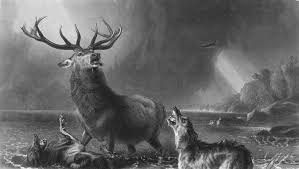
The stag beetle resembles an escapee from a Victorian beetle collection - its mandibles reminiscent of the antlers of that classic Victorian 'Stag at Bay'.
The male’s modified mandibles, gleaming, huge, and antler-like, do indeed give this spectacular beetle its name. It conjures up images of prehistoric woodland full of wild creatures that are larger than life - it is the biggest terrestrial beetle in Britain with the most magnificent specimens reaching three inches in length.

Binsted Woods, with its humid air and plentiful rotting stumps and logs provides an ideal environment for this nationally declining species. It is regularly sighted here on warm summer’s evenings at dusk. For this is when males are searching for females, with a low-pitched buzzing sound accompanying a somewhat cumbersome flight.
Males will fight for females, and even for a suitably decomposed log to attract a female, rearing up on their hindquarters, each trying to toss the opponent over, to leave them upturned with feet flailing. Once the opponent is thus embarrassed, the conquering male triumphantly performs a courtship ritual, circling the female with his gleaming mandibles held high.
 Such is their urge to mate, ardent male stag beetles will even futilely perform this courtship dance and mate with a dead female. Moving swiftly on ... A living and healthy female will then find a suitable spot to lay her eggs – rotting, damp soft wood with the texture of balsa wood is ideal – oak appears to be the favoured species.
Such is their urge to mate, ardent male stag beetles will even futilely perform this courtship dance and mate with a dead female. Moving swiftly on ... A living and healthy female will then find a suitable spot to lay her eggs – rotting, damp soft wood with the texture of balsa wood is ideal – oak appears to be the favoured species.
The larvae which come out of the eggs are creamy white with an amber-coloured head and six 'prolegs'. As with many insects the larval stage does nothing but eat and grow. Dead wood is not the most nourishing of diets and so it can take the larvae up to four (and sometimes more) years to reach a suitable size to go to the next stage - pupation. In fact, so poor is the diet that they have nitrogen-fixing bacteria in the gut. The resulting excrement can be more nutritious than what they have eaten; in the natural world nothing is wasted, so this provides a food source for other beetles.
After several years grubbing about in dead wood, they pupate in the soil. They make a chamber out of ground-up wood pieces and other materials stuck together with saliva. A mighty stag beetle later emerges from this chamber, for its 2 – 3 weeks of frenzied sexual activity. This is when they come to the attention of the humble human, who can't miss the low-pitched buzz of their flight, and feels privileged to have encountered such a striking creature.
